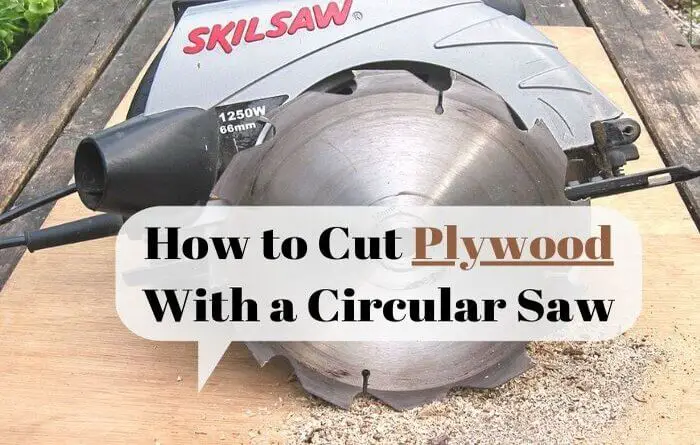How to Cut Plywood with a Circular Saw [Easy Way]
Even a basic circular saw cut plywood with ease. Home builders rely on them to cut plywood for flooring, siding and other applications. The ordinary handyman may need to cut plywood to build something whether it is shelves or cabinets or a cabin or shed for the backyard. Knowing how to cut plywood with a circular saw and what to expect from a circular saw is important for safe handling and accurate cuts.
How to Cut Plywood with a Circular Saw Step by Step
Using a right-handed hand saw with your left hand places the weight of the motor further away from your body, requiring more balancing technique when using the saw.
It also puts your body directly in the path of the shards thrown by the blade.
Tools you will need
- Circular Saw
- Safety glasses
- Tape measure
- Pencil
Step 1: Position the plywood for cutting
Place the plywood on a work surface with the finished side down to minimize bursting. Make sure that the panel is well supported and that the cut material can fall freely or be supported to prevent attachment. Tighten the plywood in place, if applicable, clamping it only in the area you intend to keep not the part that will be cut.
A few long 2 x 4 in (5.1 cm x 10 cm) posts spread over two trestles will hold the sheet steady while you cut it. Keep these posts on hand only for this type of work, as you will be cutting on them with your circular saw.
If you don’t have the posts or trestles, you can use a piece of rigid foam insulation. Spread the foam on the floor and spread the plywood sheet over it. Make sure the plywood doesn’t move on the foam board.
Step 2: Cut the plywood with the best face down
Put your plywood on to determine its best face. Mark the best face. If you are going to cut your plywood with a circular saw, you will want the plywood face down. The position of the plywood will help prevent chipping when you cut.
When using a circular saw, lay the plywood on the surface where you will cut with its best side facing down. The teeth of the blade will enter the blade from the bottom, and exit from the top. When the teeth come out, they may produce woodchips. Placing the plywood sheet with the best side facing down will ensure a smooth surface.
Step 3: Mark the cut on the plywood
Mark the cut with a tape measure and pencil, then use a checking ruler and pencil to draw a continuous cut line over your marks. For cuts longer than the ruler, use a chalk line to mark the cut line.
To make the cut smoother, mark a line. Use a utility knife to score a line before cutting. You will have to run your knife over the line several times for it to be fully marked.
A good rule of thumb is “measure twice, cut once.” If you cut the wood poorly, you won’t be able to do much to compose it. Just start over with a new piece of wood.
Draw a marking line using a pencil and a rigid ruler to avoid zigzagging!
Step 4: Choose the right type of blade.
To get a smooth cut in a sheet of plywood, you will need to have the right blade. Look for a blade with carbide tips and a high number of teeth.
You can find blades with labels that indicate they are for plywood or “finished cuts,” but be sure to check the number of teeth.
Blades come in various sizes, so be sure to get one that will fit your circular saw.
If you just keep the blade that came with the circular saw, your jobs will likely end up with chipped edges, also known as woodchips.
Step 5: Adjust the circular saw blade
Before starting to cut plywood adjust the circular saw blade to the proper depth. Adjust the blade depth by loosening the blade depth adjustment lever on the sole (the metal base of the saw) and moving the sole up or down so that the blade is deeper than the base thickness of the plywood.
Firmly tighten the blade depth adjustment lever. The 15 Amp circular saw has a gauge indicating the depth of the blade.
The blade should protrude 0.6 cm (0.25 inch) below the foil. If you’re cutting a sheet of plywood that’s 0.75 inches (1.9 cm) thick, adjust your circular saw blade to 1 inch (2.5 cm) deep.
Step 6: Prepare the cut of the plywood
In addition to the cutter, you need a suitable mark for a good cut. Hardwoods in particular, by their nature, cannot be cut directly without a blade guide.
If we were to try a freehand cut, we would inevitably have a wavy edge due to the fact that these materials have a very “slimy” behavior towards the blade and tend not to make it go too straight. With a team or a steel line as a guide, the job is easier.
Regarding non-leftist people, the line should be held firmly with the palm of the left hand and cut while holding the right knife with the right hand, always proceeding outward from the body, so as not to risk cutting ourselves off.
Step 7: Cut the plywood with a circular saw
Be careful with the power cord while cutting. Keep your work area clean.
Hold the circular saw with both hands, not touching the trigger (the saw should be turned OFF). Place the front edge of the sole over the edge of the plywood so that the guide notch on the front of the sole is aligned with the cut line. Make sure the circular saw blade is not in contact with the plywood.
Start the circular saw and slowly lower the blade into the plywood, aligning the heel guide notch with the line of cut as you move the circular saw through the cut.
Continue to push the circular saw forward with a smooth, continuous motion, using the notch to guide the cut. Maintain a good grip on the circular saw throughout the cut. Do not stop until the blade emerges from the other side of the plywood.
Release the trigger. Allow the blade to slow down and stop before setting the saw down.
If you plan to cut a lot of plywood, you should consider investing in a saw guide that will fit your circular saw. Look online or at your local supply store to find one that meets your needs.
How to get a smooth cut of the plywood using circular saw
To facilitate further work with plywood, when cutting, you need to achieve an even cut. This is not easy to do, especially if the cutting technology is not followed.
In this case, follow this recommendations to get a smoot cut of the plywood:
- Place duct tape on the cutting line. This will help maintain the integrity of the back.
- Minimize the distance between the pressure pad and the saw blade. This can be done by attaching a cover plate to the sole.
Tips and Tricks to Cut the Plywood with a Circular Saw
To effectively cut a sheet of plywood with a circular saw, you should follow these rules:
- Put the plywood on a stable support and make the first notch closer to the middle of the plywood sheet.
- Adjust the cut in depth. To do this, lower the disc and start cutting, while the immersion depth of the disc should be 0.5 cm greater than the thickness of the blade.
- Position yourself to the side of the circular saw action line to avoid injury due to the high probability of kickback.
- Prepare the circular saw for making the required cut. Attach the circular saw shoe to the blade and install the blade on the cutting line, having first bend the cover.
- Make sure there is no interference at the bottom of the sheet.
- Switch on the saw and slowly plunge its blade into the plywood sheet.
- Hold the saw firmly to prevent kickback. After plunging into the slot of the disc and installing its shoe on the surface of the sheet, return the protective casing back.
- Draw the tool along the line to the end of the plywood sheet.
- Turn off the saw and only after it has come to a complete stop, remove it from the slot.
| Tools to cut Plywood | How to Cut Plywood with Tools |
|---|---|
| 1. The circular saw | Allowing to make clean and neat cuts, it is however necessary to adapt the blade according to the wood to be cut. For solid , medium or plywood wood ,it is advisable to use the right board to avoid splitting. With this type of power tool, the best is to use the right rotation speed (the faster the better) but also to make a regular and linear movement. |
| 2. The manual saw | Certainly the most physical way for cutting plywood, but just as effective. Back saw, handsaw or Japanese saw there are several types of manual saws . But to say more, the most widespread and recommended for cutting plywood panels: it is the handsaw !! |
| 3. The jigsaw | Ideal for making curved, rounded or straight cuts, the jigsaw will allow you to express yourself as an artist in front of his canvas. |
How to Cut Plywood with a Circular Saw without Splintering
It is recommended to cut on a flat floor. The plywood sheet is laid on wooden blocks of equal thickness, placed perpendicular to the cut line.
Full support from the bottom ensures that the corner of the sheet will not break off at the end of the cut. A metal or wooden guide is installed on top, which is fixedly fixed with clamps.
In order to cut laminated plywood with a circular saw without splintering, follow this steps:
- Set the minimum cutting depth. On the opposite side of the sheet, the teeth should protrude 2-3 mm. With this setting of the cutting depth, the blade does not cut, but neatly cuts the wood.
- Choosing the right circular saw.
- For a gentle cut, a blade with a minimum size and a large number of teeth is selected (for example, No. 140).
- Low feed speed of the cutting blade when moving without stopping.
- In this case, the teeth do not chop, but gently cut the plywood without chipping.
- In order to properly cut the film faced plywood, it is also recommended to set the blade speed to maximum. Disadvantage of this method: the carpenter runs the risk of overheating the circular saw.
- Placement of adhesive tape in place of the cut.
- For this, it is recommended to use masking tape that does not leave marks on the surface of the sheet.
- At the end of the work tape is removed at 90 ° for movement in the direction of the cut.
If laminated plywood is to be processed, it is recommended to tape the sole of the circular saw with tape. This avoids scratches on the face of the sheet.
Conclusion
Thanks to a circular saw, you can cut plywood sheets of any shape, but more often this tool is used to obtain rectangular sections. The rotational speed of the circular saw is very high, so it is rather difficult to get an even cut.
To get a clean cut, you need to use fine-toothed discs designed for woodworking. Although this does not guarantee the absence of irregularities in the cut. After cutting the plywood with a circular saw, you will also have to work with a sander.




